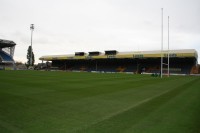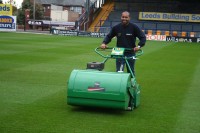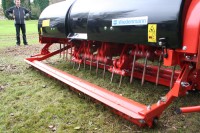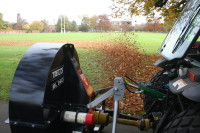November Rugby Diary
 Weather in November can often be unpredictable; last year we had a number of frosts and flood that affected playing surfaces. Playing on frosted and flooded pitches will only cause damage to the playing surface. Wait for the frosts to clear and allow time for the saturated pitches to drain before use or, indeed, using equipment on the pitch.
Weather in November can often be unpredictable; last year we had a number of frosts and flood that affected playing surfaces. Playing on frosted and flooded pitches will only cause damage to the playing surface. Wait for the frosts to clear and allow time for the saturated pitches to drain before use or, indeed, using equipment on the pitch.
You will soon lose grass cover if you play on wet playing surfaces. Grass growth is slowing down due to the low soil and air temperatures. Grass struggles to grow when temperatures drop down below 5 Degrees C. So, grass growth recovery after damage is limited.
RFU guidelines stipulate that the accepted heights of cut during the winter months should be maintained between 30mm to 90mm.
Many junior club pitches tend to have grass on their pitches that is too long. I regularly see rugby pitches that are not cut on a regular basis and the grass length often exceeds 125mm, far too long, thus it becomes weak, straggly and often flattened after play or training.
 Most senior clubs now maintain their pitches between 30-40mm, giving them a faster surface to play on.
Most senior clubs now maintain their pitches between 30-40mm, giving them a faster surface to play on.
Ensure your mowers have sharp, well-adjusted blades and that there are no oil leaks.
The presentation of the pitch is important. If it looks tidy and well presented with bands and stripes it often inspires the players to perform and, more importantly, gives them a safe, consistent surface.
Check with the sports governing body (RFU) for any amendments to the laws and markings of the pitch. Care should be taken when initially marking out new lines, ensuring that they are true, straight and measured correctly, using the 3,4,5 method to achieve accurate angles.
There are a number of marking machines available on the market, wheel to wheel, spray jet, dry liners and aerosol markers. The choice will be dependent on cost, area to be marked and the type of line you want.
The following four points are essential requirements to help achieve accurate line marking: Ensure you have serviced your machine and it is clean and ready for use.
- A reliable, accurate line marking machine
- Appropriate, approved marking fluid
- Careful planning and preparation (setting out lines)
- Time and care
Soil based pitches, generally the heavy clay and clay loam ones, will be susceptible to surface damage during wet weather, especially when the top 100mm becomes saturated.
Soils, when saturated, lose their stability and strength. Damage from scrummage and line out play are the main causes of damage on rugby pitches during wet weather periods. The severity of the damage will be dependent on the soil type and the ability of the top 100mm to drain quickly.
 To help keep the top 100mm free draining a programme of surface aeration is necessary. This is achieved by regular spiking with solid/slit tines to a depth of 150mm or more when conditions allow.
To help keep the top 100mm free draining a programme of surface aeration is necessary. This is achieved by regular spiking with solid/slit tines to a depth of 150mm or more when conditions allow.
There are other specialist machines that can help with improving surface drainage, for example the Blec Ground breaker and the versatile vertidrain machines that are now available. In recent years we have seen the introduction of linear aerators, machines that cut a slot through the soil profile, usually at 200mm centres.
Some clubs have more than one pitch; to help maintain good grass cover it will often pay to rotate the use of the pitches leaving one to recover. Also, try and get the coaches to use different parts of the pitch for warm ups.
Diseases can still be prevalent in November due to the cool, wet ground conditions, and particularly with heavy dews on the playing surfaces. It is important that groundstaff remove these dews to prevent disease attack. Many stadium clubs are experiencing outbreaks of leaf spot and red thread. A dose of approved chemical fungicide will help control and prevent the spread of these diseases.
A wetting agent is sometimes used with the fungicide to help ensure it penetrates deep enough into the soil profile. With the sun now lower in the sky, shade problems in stadium environments tend to be increased. The sun tends to cast longer shadows that often remain on the ground for long periods. Shaded areas tend to take longer to warm up and dry out, which in turn may affect maintenance operations and playability.
Earthworm activity usually increases in November. Earthworms can survive in a wide range of conditions, but most earthworm activity is dependent on the quality of food available. Worms like plenty of Organic Matter (OM), therefore pitches with a high thatch problem tend to encourage worm activity. Soil pH also affects where earthworms are found. In strongly acid or alkaline soils earthworms are rarely seen (pH less than 4.5 or greater than 8). The soil texture will also affect the number of earthworms found; they prefer clay soils and are less frequently found in sandy soils.
Worm activity inevitability leads to worm casts appearing on the playing surface. These worm casts can be very problematic; casts tend to smear the surface, which in turn can affect surface water drainage capacity as well as providing a seed bed for weed germination.
 Leaf clearance will also be a priority. Wet leaves left on playing surfaces will eventually cause problems, they will affect line marking and, if left on the surface for too long, will cause the turf to become yellow and even begin to die. The use of blowers and sweepers will help keep surfaces clean.
Leaf clearance will also be a priority. Wet leaves left on playing surfaces will eventually cause problems, they will affect line marking and, if left on the surface for too long, will cause the turf to become yellow and even begin to die. The use of blowers and sweepers will help keep surfaces clean.
November tasks for Rugby Union
Aeration / When conditions allow / Hand or machine aeration to aid surface drainage, varying depths of penetration to prevent the development of a soil pan. As last month, if there is opportunity to aerate, then do it. Regular autumn aeration provides air space for the roots to expand into and the plant to breathe. Achieving an improved root system will stand you in good stead for the coming winter months.
Brushing/sweeping / Daily / To remove dew and remove surface debris. Using a brush or a SISIS quadraplay will restore levels and produce striping or banding aesthetics.
Disease/ Inspect Daily / Keep and eye on fungal disease attack, and use approved fungicides to treat infected areas. Early morning dew on playing surfaces often promotes the chance of disease attack. Regular brushing off the dew will help prevent an attack of turf disease.
Drainage / Weekly / Inspect drainage outfalls, channels and ditches. Ensure that they are working.
Fertiliser programme / If grass shows signs of stress (weak growth, discoloured). Fertiliser treatment and turf tonics can be continued in accordance with your annual programme. If you haven't got a fertiliser programme, have your soil tested; try an independent soil analysis company for an impartial set of results.
Generally, no fertiliser applications are made during the winter months, as plant growth has slowed down. However, some groundstaff may apply a dose of liquid iron to colour up and provide some strength to the grass plant during the winter months.
Goal posts / Weekly / Inspect goal posts and sockets to check they are safe and secure.
Grooming/ verticutting / As required / Grooming and verticutting are operations that remove unwanted side growth and reduce the amount of debris in the sward. These operations are completed in conjunction with your mowing regimes. Brushing the pitch in the opposite direction prior to cut will produce a cleaner finish and a healthier sward when used in partnership with verti-cutting.
Harrowing/raking / When conditions allow / Helps to restore levels and keep surfaces open.
